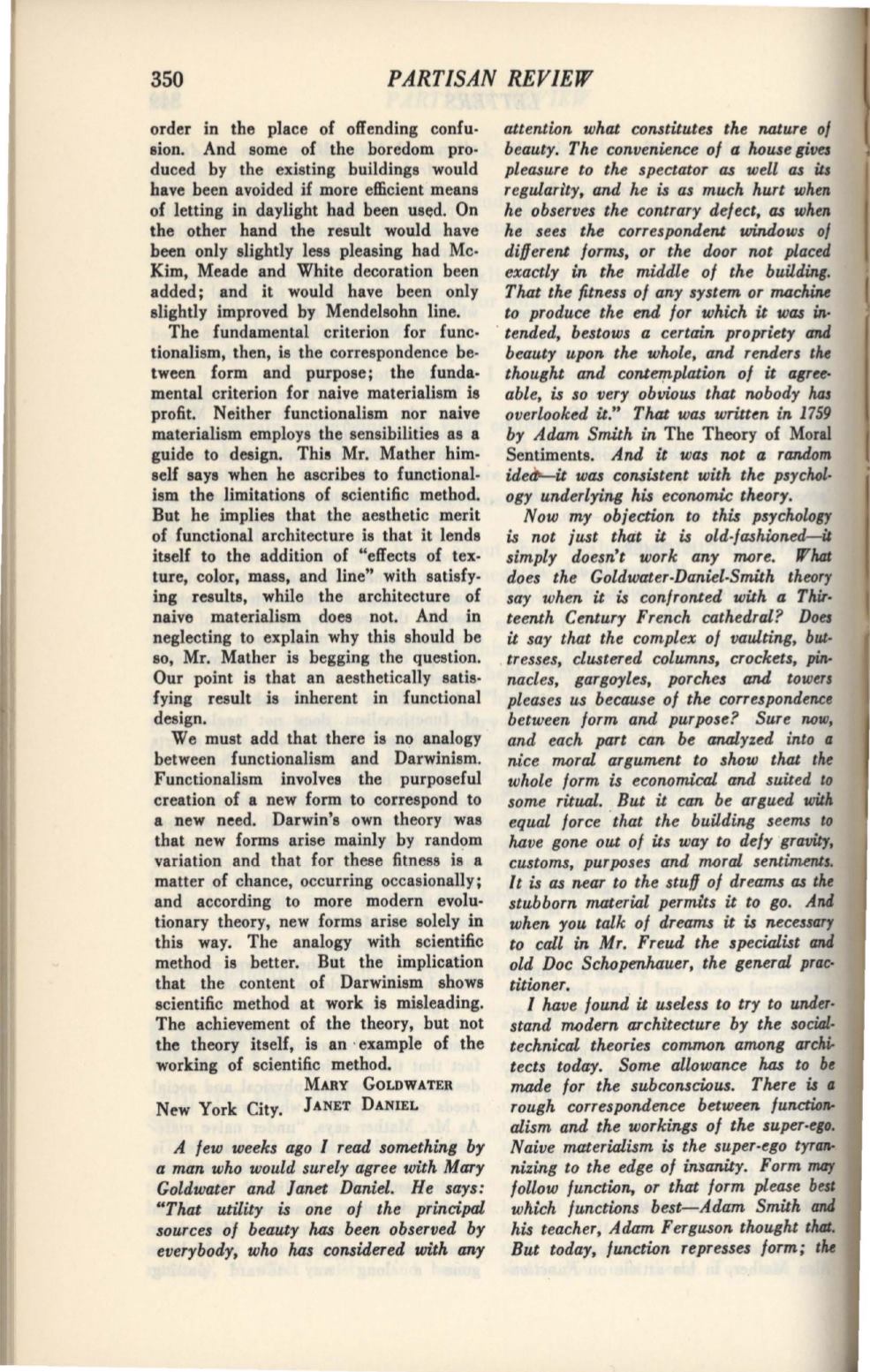
350
PARTISAN REVIEW
order in the place of offending confu–
sion. And some of the boredom pro–
duced by the existing buildings would
have been avoided if more efficient means
of letting in daylight had been used. On
the other hand the result would have
been only slightly less pleasing had
Mc–
Kim, Meade and White decoration been
added; and it would have been only
slightly improved by Mendelsohn line.
The fundamental criterion for func·
tionalism, then, is the correspondence be–
tween form and purpose; the funda–
mental criterion for naive materialism is
profit. Neither functionalism nor naive
materialism employs the sensibilities as a
guide to design. This Mr. Mather him–
self says when he ascribes to functional–
ism the limitations of scientific method.
But he implies that the aesthetic merit
of functional architecture is that it lends
itself to the addition of "effects of tex–
ture, color, mass, and line" with satisfy–
ing results, while the architecture of
naive materialism does not. And in
neglecting to explain why this should be
so, Mr. Mather is begging the question.
Our point is that an aesthetically satis–
fying result is inherent in functional
design.
We must add that there is no analogy
between functionalism and Darwinism.
Functionalism involves the purposeful
creation of a new form to correspond to
a new need. Darwin's own theory was
that new forms arise mainly by random
variation and that for these fitness is a
matter of chance, occurring occasionally;
and according to more modern evolu–
tionary theory, new forms arise solely in
this way. The analogy with scientific
method is better. But the implication
that the content of Darwinism shows
scientific method at work is misleading.
The achievement of the theory, but not
the theory itself, is an ·example of the
working of scientific method.
MARY GoLDWATER
New York City. JANET DANIEL
A few weeks ago I read something by
a man who would surely agree with Mary
Goldwater and Janet Daniel. He says:
"That utility
is
one of the principal
sources of beauty
has
been observed by
everybody, who has considered with any
attention what constitutes the nature of
beauty. The convenience of a house gives
pleasure to the spectator as well as its
regularity,
and
he
is
as much hurt when
he observes the contrary defect, as when
he sees the correspondent windows of
different forms, or the door not placed
exactly
in
the middle of the building.
That the fitness of any system or machine
to produce the
end
for which it was in·
tended, bestows a certain propriety
and
beauty upon the whole, and renders the
thought and contef!J.plation of it
agree·
able,
is
so very obvious that nobody has
overlooked it." That was written in 1759
by Adam Smith in
The Theory of Moral
Sentiments.
And it was not a random
idetf.-it was consistent with the psychol–
ogy underlying his economic theory.
Now my objection to this psychology
is
not just that it
is
old-fashioned-it
simply doesn't work any more. What
does the Goldwater-Daniel-Smith theory
say when it
is
confronted with a Thir–
teenth Century French cathedral? Does
it say that the complex of vaulting, but·
.
tresses, clustered columns, crockets, pin–
nacles, gargoyles, porches
and
towers
pleases us because of the correspondence
between form and purpose? Sure now,
and each part can be analyzed into a
nice moral argument to show that the
whole form
is
economical and suited to
some ritual. But it can be argued with
equal force ·that the building seems to
have gone out of its way to defy gravity,
customs, purposes and moral sentiments.
It
is
as near to the stuff of dreams as the
stubborn material permits it to
go.
And
when you talk of dreams it
is
necessary
to call in Mr. Freud the specialist
and
old Doc Schopenhauer, the general prac·
titioner.
I have found it useless to try to under·
stand modern architecture by the social–
technical theories common among archi–
tects today. Some allowance
has
to be
made for the subconscious. There
is
a
rough correspondence between functio""
alism and the workings of the super-ego.
Naive materialism
is
the super-ego tyrafl,.
nizing to the edge of inlanity. Form
may
follow function, or that form please best
which functions best-Adam Smith
and
his teacher, Adam Ferguson thought that.
But today, function represses form; the


